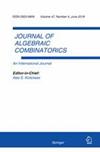An example of a non-associative Moufang loop of point classes on a cubic surface
IF 0.9
3区 数学
Q3 MATHEMATICS
引用次数: 2
Abstract
Abstract Let V be a cubic surface defined by the equation $$T_0^3+T_1^3+T_2^3+\theta T_3^3=0$$三次曲面上点类的非关联牟方环的一个例子
设V是一个三进数的二次扩展$$k=\mathbb {Q}_3(\theta )$$ k = q3 (θ)上由方程$$T_0^3+T_1^3+T_2^3+\theta T_3^3=0$$ t03 + t03 + t03 + θ t33 = 0定义的三次曲面,其中$$\theta ^3=1$$ θ 3 = 1。我们证明了在V模$$(1-\theta )^3$$ (1 - θ) 3 (k整数环)上的几何k点集合上的一个关系定义了一个可容许的关系,并且与这个可容许等价的类相关联的交换牟方环是非结合的。这就回答了余提出的一个问题。1、50多年前提出了具有点类的非关联牟方环的三次曲面的存在性。
本文章由计算机程序翻译,如有差异,请以英文原文为准。
求助全文
约1分钟内获得全文
求助全文
来源期刊
CiteScore
1.50
自引率
12.50%
发文量
94
审稿时长
6-12 weeks
期刊介绍:
The Journal of Algebraic Combinatorics provides a single forum for papers on algebraic combinatorics which, at present, are distributed throughout a number of journals. Within the last decade or so, algebraic combinatorics has evolved into a mature, established and identifiable area of mathematics. Research contributions in the field are increasingly seen to have substantial links with other areas of mathematics.
The journal publishes papers in which combinatorics and algebra interact in a significant and interesting fashion. This interaction might occur through the study of combinatorial structures using algebraic methods, or the application of combinatorial methods to algebraic problems.

 求助内容:
求助内容: 应助结果提醒方式:
应助结果提醒方式:


